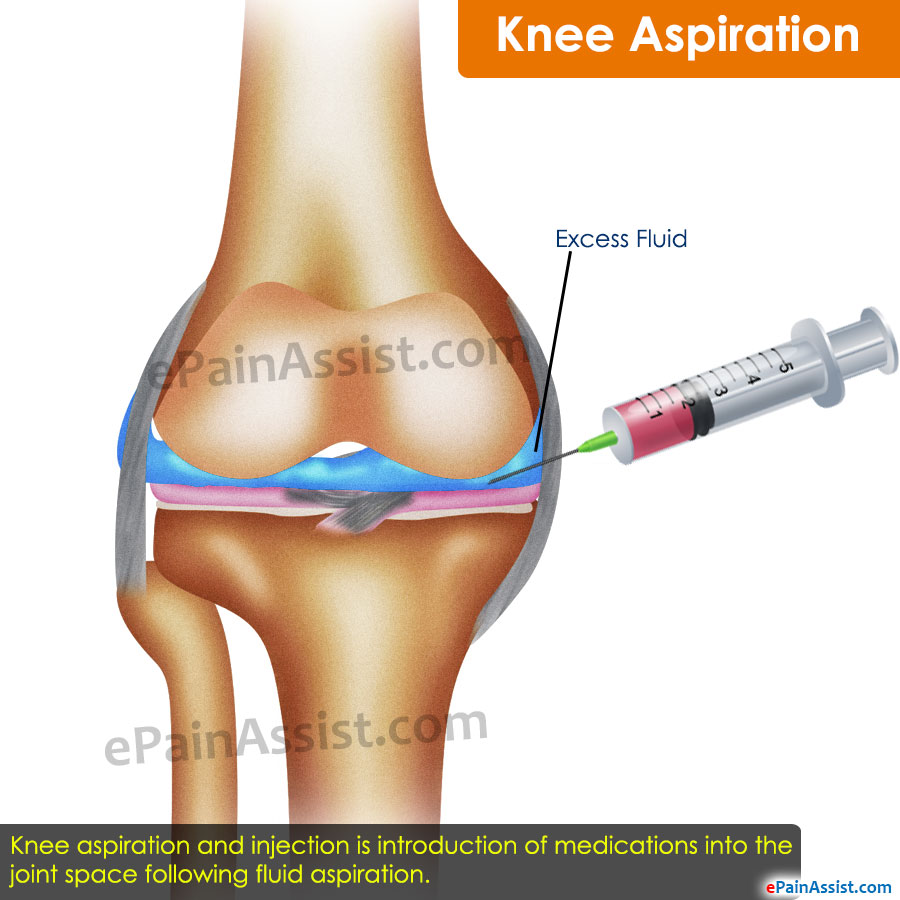The knee can get affected in injuries, joint conditions or systemic illnesses, leading to pain and swelling of the knee joint. Knee swelling is mainly accumulation of fluid in or around the joint. Knee effusion or water on knee commonly occurs due to acute trauma, arthritis and other forms of joint disorders or infection.
In such situations, knee joint aspiration, also known as arthrocentesis is performed for aspiration of excess fluid. It can be performed as a diagnostic as well as treatment modality.1
What Is Knee Aspiration?
Knee aspiration is a procedure in which a sterile needle and syringe is used to drain the excess fluid accumulated in the knee joint. It is generally performed under local anesthesia. The drained fluid can be sent for synovial fluid analysis, which can help to detect various conditions causing knee swelling.
Sometimes, drainage of sufficient amounts of excess fluid can also help in reducing the pain and swelling thus providing some relief. As a treatment modality, a procedure that enables injection of medicines into the joint after drainage of fluid may also be performed. Knee aspiration procedure is sometimes performed under the guidance of imaging studies.
When Is Knee Aspiration Performed?
Knee joint aspiration is performed for diagnostic and therapeutic purposes.
Indications Of Knee Aspiration For Diagnostic Purposes Include
- To evaluate joint effusion
- To identify intraarticular fracture
- To assess unexplained monoarticular arthritis
- To evaluate possible infective or septic arthritis
- To evaluate type of arthritis and joint related conditions
- To determine presence of crystal induced conditions like gout
- To determine the nature of accumulated fluid and cytology studies in synovial fluid analysis.
Indications Of Knee Aspiration For Therapeutic Purposes Include
- Relieving Tense Effusion – When knee swelling is large or tense or pain causes discomfort, drainage of fluid helps to relieve the pressure and pain.2 Reduction in swelling and decreased tension aids in improving joint movement.
- Drainage of Infected Fluid – In a known infective condition, drainage of septic effusion can help in providing relief, improve joint movement and prevent damage to the joint.
- Injection of Medications into the Knee Joint – Knee aspiration and injection is at times performed to provide relief in joint conditions.3
How Is Knee Aspiration Performed?
Using aseptic precautions, the swollen knee joint is examined and appropriate site is chosen. The area is cleaned with an antiseptic and a local anesthetic is used to make the site numb. The needle is inserted into the joint space and the synovial fluid is drained out. Medications may be injected into the space if required and the needle is taken out.
What Is The Recovery Period Following Knee Aspiration?
In most cases, removal of excess fluid provides great relief in reducing swelling, pain and also improves joint movement. Further medications and joint compression helps to prevent recurrence. While improvement continues; complete relief may be obtained in few weeks to months depending on the underlying cause of knee swelling. In some cases appropriate repair procedures may have to be performed.
It is important to follow medical advice regarding rest, movement of legs and other activities. It is advisable to avoid strenuous activities for a few days after the procedure. Medical opinion should be sought if there is redness, soreness, excessive pain, bleeding or oozing from the aspiration site, fever within few days of the procedure.
Are There Any Risks Associated With Knee Aspiration?
While complications due to knee aspiration are less likely, there are some risks associated with any procedure. Some risks that may be involved with knee aspiration include discomfort and pain at the local site, sometimes swelling or bruising may be seen, rarely an infection can develop at the aspiration site or within the joint.
In order to avoid such complications, proper physician training is ensured and appropriate preventive measures are implemented.
What Are The Contraindications For Knee Aspiration?
In certain cases knee aspiration may not be advisable, which include bacteremia, joint prosthesis, allergies to local anesthetics or other agents, infection or skin lesions of the overlying soft tissues and uncontrolled or severe coagulopathy.
What Is Knee Aspiration And Injection?
Knee aspiration and injection is introduction of medications into the joint space following fluid aspiration. Medications like steroids, antibiotics or other medications may be instilled into the knee joint depending on the cause and severity of the condition.
Local steroid injection can provide considerable relief, reduce discomfort and is often found helpful in acute exacerbations of chronic joint conditions that cause large knee effusion. Sometimes, after the injection, the joint may get inflamed for which appropriate treatment is given.
What Is Synovial Fluid Analysis or Knee Aspiration Fluid Analysis?
Synovial Fluid Analysis or Knee Aspiration Fluid Analysis– When there is a suspicion of a particular condition, a diagnosis needs to be established. The synovial fluid, which is drained or aspirated from the joint, is examined and analyzed in the laboratory for its nature and presence of certain factors that aid in diagnosis of the condition. Specific findings help in determining the condition causing knee swelling.
The type of fluid and its detailed analysis guides in making a diagnosis of the condition. Some of the general findings include:
- Fracture or ligament injuries may show blood in the fluid.
- Meniscus injury or osteoarthritis may show straw colored or pale yellow fluid.
- Presence of crystals may mean gout or pseudogout.
- Turbid fluid or presence of pus may mean there is an infection.
- Gram staining and culture tests of the fluid can help in detecting the microorganism causing infection.
Also Read:

